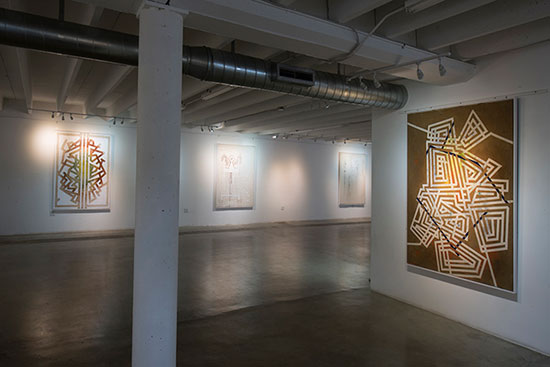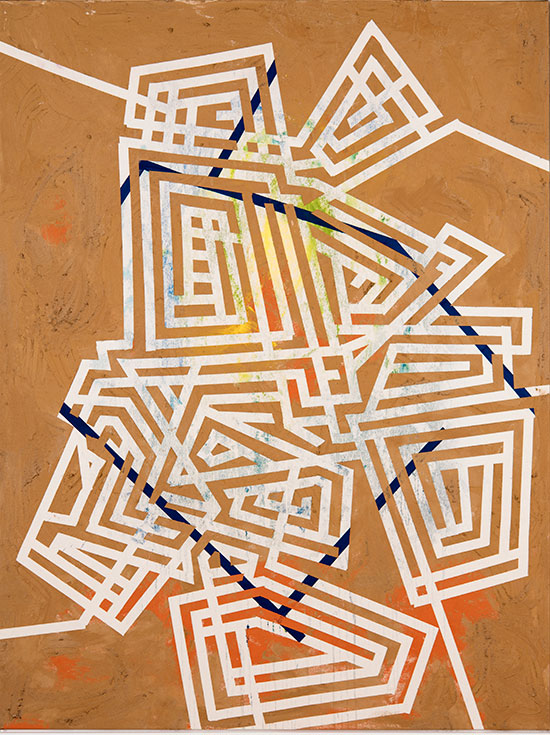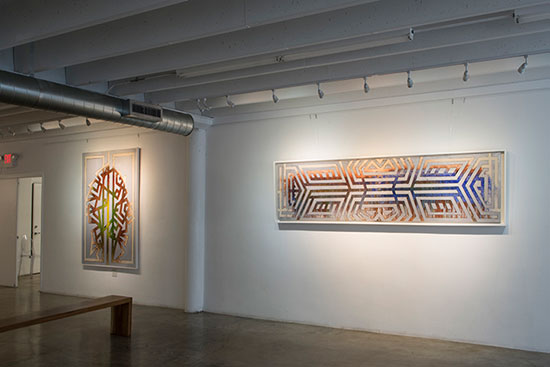A riveting tension courses through "Sublimation: Ancestral Patterns" by Ya Levy La'ford at Yeelen Gallery. It's the tension between geometric angles and free-roaming currents of cultural history that curl across continents and traverse oceans. One can see fleeting parallels here to petroglyphs left by indigenous peoples in the American Southwest and in Caribbean islands.
La'ford's 10 mixed media works on canvas reveal seductive passages—or passageways—tunneling through time. They draw viewers into unexpected connections from Picasso and 20th Century abstract art to long-standing cultures in the Americas, Africa and Asia.
Many of the works here have titles referring to African languages and tribes, such as Samburu and Wolof. The title of Pygmies can be read as a reference to short-statured peoples living in African and Asian rainforests.
.

"Pygmies" by Ya Levy La'ford, 2017. Acrylic, ink, pigment, glue alcohol, egg, bleach, heat, resin & natural weathering on canvas, 116 x 28 inches. Courtesy of Yeelen Gallery.
.

"Samburu" by Ya Levy La'ford. Acrylic, ink, pigment, glue alcohol, egg, bleach, heat, resin & natural weathering on canvas, 72 x 54 inches. Courtesy of Yeelen Gallery.
.
But these allusions go far deeper than simplistic name-dropping in titles. For much of La'ford's career, the primary focus has been on what she calls "ancestral patterns," visual traces of civilizations spanning cultures and continents. As a formally trained painter, La'ford painstakingly cultivates her understanding of modern abstraction, even as she pursues cultural quests for knowledge through travels to distant destinations including China, Colombia, Cuba, Egypt, and Thailand.
Radiant colors pulsating in paintings by Mark Rothko and the signature sensation of floating colors in Helen Frankenthaler's "color stain" paintings have led La’ford to develop her own approach to abstraction by experimenting with a host of techniques. Generally, the canvases have been painted with roughly textured colors and left to absorb the rain and weather by "curing" outside, undergoing more physical treatment by being thrown into a washing machine she uses only for this purpose.
.

"Sublimation: Ancestral Patterns" by Ya Levy La'ford at Yeelen Gallery. Foreground: "Fang." Courtesy of Yeelen Gallery.
.
An artist in her late 30s, she loves casting a wide net, stimulating her creative aesthetic with travel to places steeped in the history of human civilization. Soon after "Sublimation: Ancestral Patterns" opened, she embarked on a trip that included visits to legendary sites of Luxor in Egypt and Petra in Jordan.
Currently she lives and works in Florida and New York. Born and raised in the Bronx, La'ford is very proud of her ties to the historical art of Jamaica. She is the granddaughter of John Dunkley (1891-1947), considered a significant "intuitive" artist not only in his native Jamaica but in the broader history of the Caribbean. Presenting paintings from the 1930s and '40s as well as more figurative sculptures carved from wood and stone, "John Dunkley: Neither Day nor Night" opens at Pérez Art Museum Miami May 26, 2017.
At first glance their paintings could not seem more different. Dunkley's landscapes, replete with dense tropical vegetation, are rendered in the flattened, so-called naive style of an artist lacking formal training. He favored an often brooding, darkened palette. La'ford, who holds both a BFA and an MFA, favors bold abstractions, layered with color and texture. She revels in mixing acrylic paint with unusual, even exotic materials—including coffee, chocolate, curry, ginger, hibiscus and gold dust.
Does she consider her grandfather an influence? "Yes, especially at this moment, when they [curatorial staff at Pérez Art Museum Miami] have gathered such a body of his work and I can be alive and he can be alive in a different form." She's clearly moved by memories of learning about her grandfather's art when her parents took her as a young girl back to Jamaica to visit.
In an essay she wrote about her grandfather for PAMM, she recalled that formative time in her life: "Thinking back, I see myself sitting on the lap of my father in Kingston, Jamaica, and catching a glimpse of my grandfather's imagination for the first time. My father points out to me the spiders and their webs, the woodlands, the mountains, the plants and animals that are featured in most of my grandfather's work."
Christina Boomer Vazquez, PAMM's Deputy Director of Marketing and Public Engagement, asked La'ford to comment on her grandfather. Her essay will be posted on the museum website. As Vazquez explained via email, "I loved her backstory and was curious myself as to how her relationship with her grandfather informed her own practice … I was also hopeful her contribution would give us a window in, providing our visitors an intimate and perhaps unique look at her grandfather's work and inspiration."
In an interview on April 22, 2017, at the gallery, La'ford spoke to me about her grandfather's legacy for her as an artist: "The kind of impressions I got from him and his imagination at a very early age in Jamaica when I was on my father's knee gave me the gateway to find these passages in my imagination, just in a more abstract way."
It seems that for La'ford, such "passages," inspired by Jamaican landscapes creatively revisited in her grandfather's paintings, recur on a far more conceptual scale in her art as she deliberately builds abstract compositions with allusions spanning vast swaths of time and space.
In "Sublimation: Ancestral Patterns," the painting with the clearest presence of human figures is Les Trois Danseuses—Homage to Berber. But that presence is not so much clear as deliberately cheeky. The French text in the title and the shadowy figures in the painting itself suggest an homage to Picasso, even though the title refers specifically to an homage to the Berber pre-Arab tribe in North Africa. Conspicuously absent from the title is the Modernist master's name itself.
.

"Les Trois Danseuses" by Ya Levy La'ford, 2014. Acrylic, ink, pigment, glue alcohol, egg, bleach, heat, resin & natural weathering on canvas, 54 x 72 inches. Courtesy of Yeelen Gallery.
.
La'ford's dancing figures are mere, wispy echoes of that trio in Picasso's surreal 1925 painting, thought to be a portrait of a deadly love-triangle. As evanescent memories of a classic image in Western art, the figures are nearly obscured by the artist's persistent pattern of narrow angular lines taking up the entire space of the painting. It seems to evoke webs of finely knotted strands, perhaps recalling the ancient tradition of hand-woven Berber carpets.
"I am kind of re-representing Picasso," she explained, "and giving homage to the African people, which he generated a lot his ideas from."
Gleaming with gold leaf spliced into a dense thicket of geometric designs, Mansa Musa could almost be a massive work of filigree gold jewelry fit for a king. It projects a royal presence in synch with its title, also clearly chosen for links to African history. Mansa Musa was the 14th Century African ruler most well-known outside of Africa during the medieval period. Commanding the vast Mali Empire, he is famous for owning enormous quantities of gold as well as for his devotion to Islam. La'ford's painting slowly draws us into a flickering maze—a labyrinth which partly reveals and conceals more royal players in the distant narrative of Mansa Musa.
.

"Mansa Musa" by Ya Levy La'ford. Acrylic, ink, pigment, glue alcohol, egg, bleach, heat, resin & natural weathering on canvas, 72 x 54 inches. Courtesy of Yeelen Gallery.
.
The gravelly, messy background of Fang is an earthy mix of color combining the deep golden hue of burnt sugar and terra cotta. Close inspection reveals marks of sandy dirt swirled into the paint. In vivid contrast to this background is an overlay of white geometric lines coalescing to suggest a bird's-eye view of a city laid out with abruptly angled avenues. A few major thoroughfares in dark blue could be crossing this city: perhaps the painting is a map for a place we visit only in our minds.
.

"Fang" by Ya Levy La'ford. Acrylic, ink, pigment, glue alcohol, egg, bleach, heat, resin & natural weathering on canvas, 54 x 72 inches. Courtesy of Yeelen Gallery.
.
In contrast to Mansa Musa and Les Trois Danseuses, Fang makes a bolder use of positive and negative space, although it's not always clear what's positive and negative. That messy background can sometimes seem to lurch into the foreground. Delicately intermixed in those white lines are filmy passages of blue, yellow, and green, staining these imaginary streets with faint echoes of a verdant landscape, abstracted vaguely and delicately in the manner of Helen Frankenthaler.
Though Fang's title refers to a tribe in Central Africa, La'ford says the painting was inspired specifically by a trip to Colombia, where again she found herself confronting those ancestral patterns. "I find these patterns all over," she said. In Colombia she was especially struck by the African history of a group called the Palenque. That history is preserved in Palenque de San Basilio, a Colombian village founded by African slaves who escaped from the Spanish in the 17th Century. Today, it's settled primarily by Afro-Colombians who are direct descendants of those African slaves, and in 2005 UNESCO proclaimed the village a Masterpiece of the Oral and Intangible Heritage of Humanity.
"In some way, shape or form, I find that we are all truly entangled," La’ford said. Her art is an ongoing testament to that belief.
.

"Sublimation: Ancestral Patterns" by Ya Levy La'ford at Yeelen Gallery. Foreground: "Fang." Courtesy of Yeelen Gallery.
.
___________________________
BASIC INFO: "Sublimation: Ancestral Patterns" by Ya Levy La'ford is on view from April 22 to May 27 at Yeelen Gallery, 294 NW 54th St, Little Haiti, Miami, Florida 33127. www.yeelenart.com
____________________________
Copyright 2017 Hamptons Art Hub LLC. All rights reserved.
